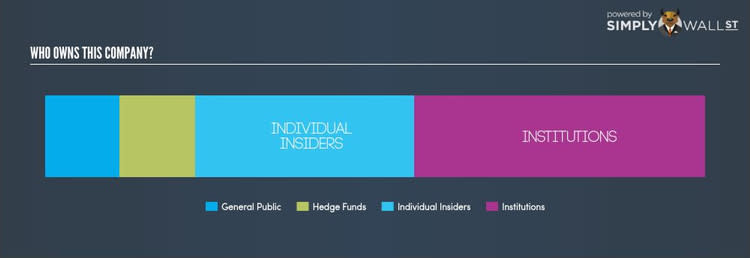Who Owns The McClatchy Company (MNI)?

Today, I will be analyzing The McClatchy Company’s (AMEX:MNI) recent ownership structure, an important but not-so-popular subject among individual investors. When it comes to ownership structure of a company, the impact has been observed in both the long-and short-term performance of shares. Since the same amount of capital coming from an activist institution and a passive mutual fund has different implications on corporate governance, it is a useful exercise to deconstruct XYZ’s shareholder registry. All data provided is as of the most recent financial year end.
Check out our latest analysis for McClatchy
Institutional Ownership
MNI’s 44.00% institutional ownership seems enough to cause large share price movements in the case of significant share sell-off or acquisitions by institutions, particularly when there is a low level of public shares available on the market to trade. However, as not all institutions are alike, such high volatility events, especially in the short-term, have been more frequently linked to active market participants like hedge funds. Considering hedge funds hold a stake of 11.49% in the company, MNI shares may experience high short-term volatility as this class of institutions are frequently found to sell significantly during market-wide shocks. I am going to further examine MNI’s ownership structure to check how other major shareholders can affect its investment case.
Insider Ownership
Insiders form another group of important ownership types as they manage the company’s operations and decide the best use of capital. Insider ownership has been linked to better alignment between management and shareholders. 33.16% ownership of MNI insiders is large enough to make an impact on shareholder returns. In general, this level of insider ownership has negatively affected underperforming (consistently low PE ratio) companies and positively affected the companies that outperform (consistently high PE ratio). It’s also interesting to learn what MNI insiders have been doing with their shareholdings lately. Insider buying may be a sign of upbeat future expectations, however, selling doesn’t necessarily mean the opposite as insiders may be motivated by their personal financial needs.
General Public Ownership
A substantial ownership of 11.35% in MNI is held by the general public. This size of ownership gives retail investors collective power in deciding on major policy decisions such as executive compensation, appointment of directors and acquisitions of businesses. This level of ownership gives retail investors the power to sway key policy decisions such as board composition, executive compensation, and potential acquisitions. This is a positive sign for an investor who wants to be involved in key decision-making of the company.
What this means for you:
Are you a shareholder? I suggest investors seek some degree of margin of safety due to high institutional ownership in MNI, in particular due to the strong presence of active hedge fund investors. This will allow an investor to reduce the impact of non-fundamental factors, such as volatile block trading impact on their portfolio value. If you’re interested in bolstering your portfolio with new stocks and are looking for ideas, take a look at our free app to see my list of stocks with a strong growth potential.
Are you a potential investor? Ownership structure should not be the only determining factor when you’re building an investment thesis for MNI. Rather, you should be examining fundamental factors like the intrinsic valuation of MNI, which is a key driver of MNI’s share price. Take a look at our most recent infographic report on MNI for a more in-depth analysis of these factors to help you make a more well-informed investment decision.
NB: Figures in this article are calculated using data from the last twelve months, which refer to the 12-month period ending on the last date of the month the financial statement is dated. This may not be consistent with full year annual report figures.
To help readers see pass the short term volatility of the financial market, we aim to bring you a long-term focused research analysis purely driven by fundamental data. Note that our analysis does not factor in the latest price sensitive company announcements.
The author is an independent contributor and at the time of publication had no position in the stocks mentioned.


